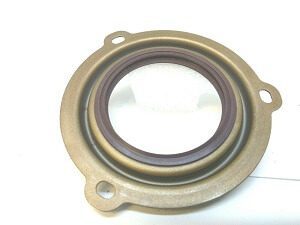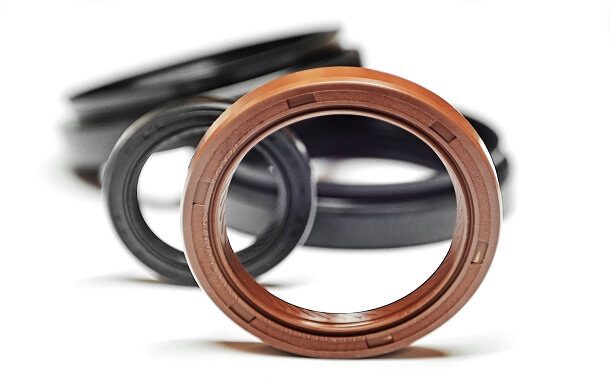Transmission Front Seal Leak Repair Cost
Last Updated on December 13, 2021
Written by CPA Alec Pow | Content Reviewed by ![]() CFA Alexander Popinker
CFA Alexander Popinker
The transmission is a complex system that helps with one of the main functions of any car. It consists of a multitude of components, which have individual roles but are constantly interconnected in order to make the vehicle work. Being an essential element in the structure of the car, it is important to know some technical details about each component. You also need to know what faults can occur and how you can prevent or spot them.
A special fluid is used to keep the transmission parts from wearing down, and this oil is kept under control by an intricate system of seals. The front seal in particular has a high priority for maintaining smooth operations with your car’s engine.
How much does the transmission front seal leak repair cost?
If you need to replace a leaking front transmission seal you will have to pay anywhere between $160 and $620, with and an average price of almost $310. Because the mechanic has to disassemble a large portion of the transmission assembly in order to replace the front transmission seal, these are the most expensive seals to replace.
It is not a difficult job to actually replace the transmission seal but it does take a lot of labor and time because the mechanic has to disassemble the transmission and, in most cases, drain the fluid. So, you will have to pay the most for the labor.
In the table below you will find the average costs to replace the transmission front seal for some of the most common types of vehicles.
| Make/Model | Price |
|---|---|
| Honda CRV | $275 |
| Honda Civic | $210 |
| Toyota Corolla | $400 |
| Toyota Camry | $430 |
| Ford Fusion | $200 |
| Ford Mustang | $200 |
| Chevy Silverado | $450 |
| Ford F-150 | $210 |
| Audi A4 | $500 |
| Nissan Altima | $250 |
| BMW 3 Series | $400 |
As you can see, it is not so expensive to replace the transmission seals. In general, the costs for front seal replacement are similar to those for rear or output seal replacement.
Every transmission has a rear output shaft as well, which has its own seal. Even though these are a little bit larger, the design and cost are similar to the front seal. However, these car parts are more accessible to the mechanic and will not require so much work resulting in a lower cost. You should expect to pay around $220 to replace a leaking rear transmission seal, depending on the car’s age and the service location.
In the table below you will find the average cost of replacing a rear transmission seal for different types of cars.
| Make/Model | Price |
|---|---|
| Honda CRV | $300 |
| Honda Civic | $200 |
| Toyota Corolla | $380 |
| Toyota Camry | $400 |
| Ford Fusion | $170 |
| Ford Mustang | $190 |
| Chevy Silverado | $400 |
| Ford F-150 | $200 |
| Audi A4 | $470 |
| Nissan Altima | $220 |
| BMW 3 Series | $410 |
Factors that influence the cost of transmission seal replacement
Make and model of the car
Depending on what type of vehicle you drive there’s usually some kind of disassembly required which can cost more than just replacing partials because they’re not as sophisticated internally.
Transmission type
You might also like our articles about the cost of oil leak repair, exhaust leak repair, or radiator flush.
A manual transmission may be a more affordable option for some car owners. This is because the parts are less sophisticated and repair can cost less than what you would spend on automatic transmissions, which use computerized technology instead of physical gears or levers to change gear ratios.
Age of the car
Just like there are different types of engines in cars, these engines also have their own seal requirements. Most modern-day vehicles use standardized seals which means you can find these replacement parts at any auto shop for fairly cheap. However, older models may require obsolete parts no longer produced by manufacturers or even parts individually tailored specifically to your vehicle type.
Materials
Transmission seals are usually made from a material like rubber or plastic, but some have metal reinforcement such as aluminum, steel, or copper in order to keep them strong under pressure. Stainless steel gaskets work well for high-heat environments, while silicone can provide an even stronger bond between your car’s gearbox and engine block.
Transmission front seal leak details
In order to prevent leaking, your transmission has a front and back seal. These are important for keeping pressure on the inside of it so that no fluid can seep out onto other parts or cause damage when changing gears in cars. There are two major transmission seals known as the output shaft seal and the front seal or the input shaft seal.
Transmission seals are there to protect the transmission from unnecessary dirt, debris, and corrosion while ensuring that it stays lubricated. The input shaft connects with your car’s converter in order for both parts to work together as one unit.
The fluid in your transmission will start leaking when the seal breaks, making it increasingly difficult to shift gears.
Important things to consider
It is recommended by the experts to replace the transmission seals once every 100,000 to 150,000 miles. However, the seals may need to be changed faster if you don’t change the transmission fluid regularly.
Even though you can still drive with a damaged transmission seal it must be replaced as soon as possible because it can cause even bigger problems to your car.
It would take only around 30 minutes to replace the transmission seal itself, but what takes longer is the work necessary to get access to the seals. A mechanic will need 4 to 6 hours to disassemble all the car parts.
Signs of a Bad Transmission Front Seal
 Any transmission issues are part of that category of problems that will be seen in the proper operation of your car. That is, if your car is suffering from a transmission issue, you will feel this through several signs.
Any transmission issues are part of that category of problems that will be seen in the proper operation of your car. That is, if your car is suffering from a transmission issue, you will feel this through several signs.
Low fluid levels or leaks
A fairly common transmission problem can occur either from a low level of transmission fluid or from a certain leak. This type of leak can occur when there are problems with the transmission seals.
Difficulty shifting
The hard shifting could be an indication that your transmission shaft is leaking and needs to be replaced. As fluid leaks out, the parts have a harder time moving against each other which makes for sluggish behavior in car transmissions.
Grinding noises
The grinding noise coming from your transmission could be an indication that there’s not enough fluid in it. Transmission oil acts as a cushion for the different parts to glide past one another without being scratched or damaged, so when you notice this type of scraping sound, chances are high that some necessary components (such as a transmission seal) need immediate attention.
Vibrating transmission
A bad transmission front seal will cause the car’s engine to shake or vibrate when you engage it. This is a sign that there isn’t enough fluid in your transmission, and driving with low levels can damage other parts of your vehicle.
How can I save money?
If you are thinking about saving some money on the labor cost, you can replace the transmission front seal yourself, but there are some steps that you will have to follow.
First of all, you have to lift the car in order to have access to the undercarriage and transmission box. Do not forget to put the gear shift in neural before performing this job.
Once you lift the car try to locate the front seal and disassemble all the car parts in order to gain access to it. These may include the torque converter, the engine belt, the transmission key, or the balancer bolt. Pay attention or write somewhere how these parts are assembled as to put back as before.
After that, with the help of a screwdriver, you will have to pry out the driveshaft and loosen the seal and remove it.
The next step is to put some oil on the seal opening and fix the new seal in place. Finally, you have to put back all the car parts and ensure that the transmission key is correctly aligned.



Leave a Reply
Want to join the discussion?Feel free to contribute!